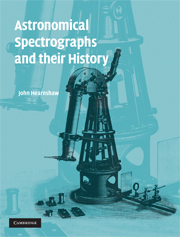Book contents
- Frontmatter
- Contents
- Preface
- Acknowledgements
- 1 The historical development of astronomical spectroscopes and spectrographs
- 2 The theory of spectroscopes and spectrographs
- 3 High resolution spectrographs
- 4 Solar spectrographs and the history of solar spectroscopy
- 5 Objective prism spectrographs
- 6 Ultraviolet and nebular spectroscopy
- 7 Multi-object spectrographs
- 8 Ten pioneering spectrographs of the late twentieth century
- Figure sources and acknowledgements
- Name index
- Subject index
4 - Solar spectrographs and the history of solar spectroscopy
Published online by Cambridge University Press: 07 September 2010
- Frontmatter
- Contents
- Preface
- Acknowledgements
- 1 The historical development of astronomical spectroscopes and spectrographs
- 2 The theory of spectroscopes and spectrographs
- 3 High resolution spectrographs
- 4 Solar spectrographs and the history of solar spectroscopy
- 5 Objective prism spectrographs
- 6 Ultraviolet and nebular spectroscopy
- 7 Multi-object spectrographs
- 8 Ten pioneering spectrographs of the late twentieth century
- Figure sources and acknowledgements
- Name index
- Subject index
Summary
SPECTROSCOPY OF THE SOLAR CHROMOSPHERE
The discovery of helium
A new era in solar spectroscopy was launched in the late 1860s when a series of solar eclipses provided an opportunity to study the solar chromosphere. This is the hot tenuous layer lying above the photosphere, which is the region of the Sun that emits the vast proportion of the visible light. At the time of a total solar eclipse, it was well known by the 1860s that the light from the thin chromospheric layer (with a height of ∼ 10 to 12 arc seconds or 8000 to 10 000 km) became briefly visible. Moreover, the solar prominences are large structures of chromospheric material extending out from the limb, often a minute of arc or more in height. They too were seen at times of eclipse, and the question of the physical conditions in the chromosphere and prominences arose. The spectroscope was the natural tool to settle the issue. If they were comprised of hot low density gas, then bright emission lines would be expected, as William Huggins pointed out, and hence they should have spectra similar to those of the gaseous nebulae, such as the Orion nebula. Huggins also believed that if bright lines were present, then perhaps they could be observed with suitable glass filters to isolate the line radiation, even outside of eclipse, but attempts to do so did not come to fruition.
- Type
- Chapter
- Information
- Astronomical Spectrographs and their History , pp. 96 - 139Publisher: Cambridge University PressPrint publication year: 2009



